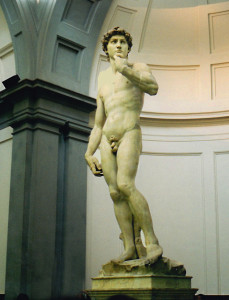The overseers had hoped Michelangelo, already known for his Pieta in Rome’s St. Peter’s Basilica, could use the discarded but still valuable marble to create a prosaic statue to fit into a niche near the roofline of their domed cathedral. Michelangelo had grander ideas. He worked more than two years in his Florence studio releasing his classic image of David from the marble. When completed in 1504, David was more than 17 feet tall and weighed 12.000 pounds, making the intended location high above the ground impractical. More important, the citizens of Florence saw in the heroic figure of David a reflection of their own resistance to domination from Rome and the Medici’s and wanted the statue to be seen. They positioned David just outside city hall, his watchful gaze directed toward Rome. The statue quickly became the symbol of the Florentine Republic and its leading role in the Italian Renaissance.
The sinewy David demonstrated Michelangelo’s extraordinary knowledge of human anatomy, garnered from corpses he dissected when only 18. But the anatomical correctness was too much for Queen Victoria, who received a replica of the statute as a gift from the Duke of Tuscany in 1857. She ordered that an 18-inch wide plaster fig leaf be hung strategically on hooks when she and other royal ladies visited the museum where David was displayed.
After braving the elements for 369 years, Michelangelo’s masterpiece was moved into Florence’s Galeria dell’Accademia for protection and its position outside city hall taken up by a replica. Visitors to the Accademia can also see Michelangelo’s four “Unfinished Slaves,” in which incomplete figures seem to be straining to emerge from the surrounding marble. Whether Michelangelo abandoned these works or intentionally left them unfinished to show the struggles of human existence is not clear. What is clear is that Michelangelo could work miracles with unfinished blocks of marble.

Comments are closed.